How Long Should You Stay Out of House After Refinishing Floors?
Updated: 11/18/2025
Reading Time ~ 18 minutes

Table of Contents
- When Is It Safe to Sleep in the House After Polyurethane Application?
- Can You Sleep Upstairs or In a Different Room While Polyurethane Floors Are Drying?
- What Are the Health Risks of Sleeping in a House with Fresh Polyurethane Fumes?
- How Can You Remove Polyurethane Smell and Speed Up the Time When It’s Safe to Sleep in the House?
Most healthy adults should plan to stay out of the house for about 2–3 nights after water-based polyurethane and 3–7 nights after oil-based polyurethane before sleeping there again, with windows open and ventilation running the whole time. Babies, pregnant women, and people with asthma need a much bigger safety margin.
There is more nuance behind those numbers, but they give you a realistic starting point for planning where you and your family will sleep.
When Is It Safe to Sleep in the House After Polyurethane Application?
For most jobs, healthy adults can usually sleep in the house again after about 2–3 days with modern water-based polyurethane, and after about 3–7 days with traditional oil-based polyurethane, assuming strong ventilation the whole time. Sleeping is a higher bar than just walking through the room, because you’re lying low and breathing the same air for many hours.
Those ranges come from a mix of manufacturer guidance and real-world projects where people tried to move back too fast and paid with headaches and irritated lungs. Walking through a refinished room for a minute is one thing. Sleeping there, with doors partly closed and windows not wide open all night, is something else entirely.
How Long Should You Wait Before Sleeping After Water-Based Polyurethane?
With water-based polyurethane, healthy adults can usually plan to sleep in the house again after 2–3 nights out with steady ventilation. Water-based products dry to the touch in a few hours and often allow light sock traffic after about a day, but the air still needs time to clear before you use the house for full overnight living.
The big selling point of water-based finishes is lower odor, not zero chemicals. Even with low-VOC options, there are still polyurethane fumes in the air while the coating dries and cures. If you have babies, toddlers, pregnancy, or asthma in the family, treat that 2–3 day window as a minimum and add extra days before you let them sleep in the refinished area every night.
How Long Should You Wait Before Sleeping After Oil-Based Polyurethane?
With oil-based polyurethane, it’s safer to think in terms of 3–7 days out of the house before anyone sleeps there. Oil-based systems dry slowly, release more VOCs, and create the classic strong polyurethane smell that can hit you as soon as you open the door.
The floor might feel dry enough after a day, and you might even be told you can walk on it carefully, but the air will usually stay heavy for much longer. For one small room and only healthy adults, you might be comfortable at the shorter end of that 3–7 day range. For a whole main floor or sensitive family members, planning closer to a full week before sleeping there is a much better bet.
How Do Floor Area and Number of Coats Affect When It Is Safe to Sleep in The House?
The more square footage and coats of polyurethane you have, the longer it takes before the house is comfortable and safe for sleep. A single bedroom with two coats of water-based poly clears out much faster than an entire open-plan main floor with three or four coats of oil-based finish.
Each fresh coat adds more solvent to the air and resets the clock. If your refinisher is applying multiple coats over several days, the fumes never really drop until the last coat is done. From that final application, you still count your 2–3 days for water-based or 3–7 days for oil-based as the baseline for sleeping, then adjust based on how strong the polyurethane smell still feels when you walk in.
What Is the Difference Between Dry to Walk and Safe to Sleep After Refinishing?
Dry to walk means the polyurethane film is firm enough that your shoes or socks won’t mark it. Safe to sleep means the room air has cleared enough that you’re not spending the whole night inhaling elevated VOCs. One is about protecting the finish from damage; the other is about protecting your lungs and nerves.
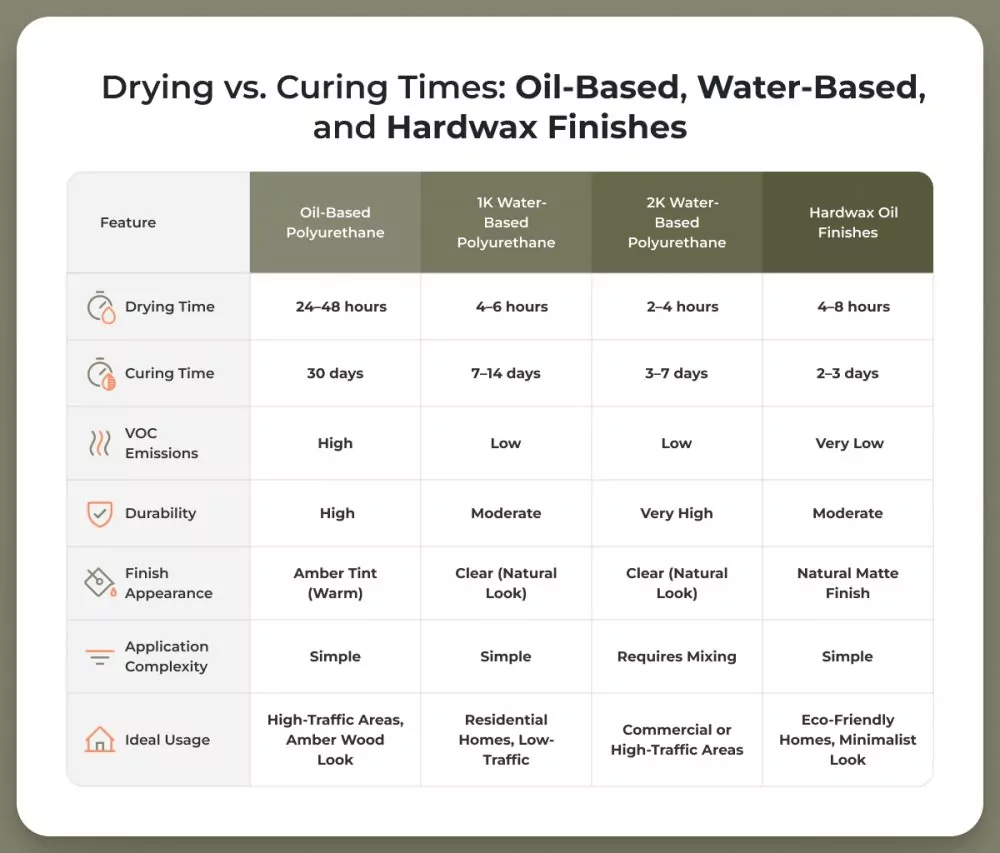
Is It Really Necessary to Leave the House with Modern Low-Odor Polyurethane Finishes?
Even with modern low-odor water-based polyurethane, it’s still smart to plan at least a couple of nights away before sleeping in the house again. Low odor does not mean no VOCs, and closed bedrooms can concentrate whatever is left in the air.
I hear the same question constantly: the finish hardly smells, so can you sleep in the house after polyurethane if it’s a new water-based system? Compared to old oil-based products, yes, you can usually return sooner. But if you have kids, pregnancy, asthma, or just a low tolerance for chemical smells, leaving for 2–3 nights and running strong ventilation while you’re gone is a modest price to pay.
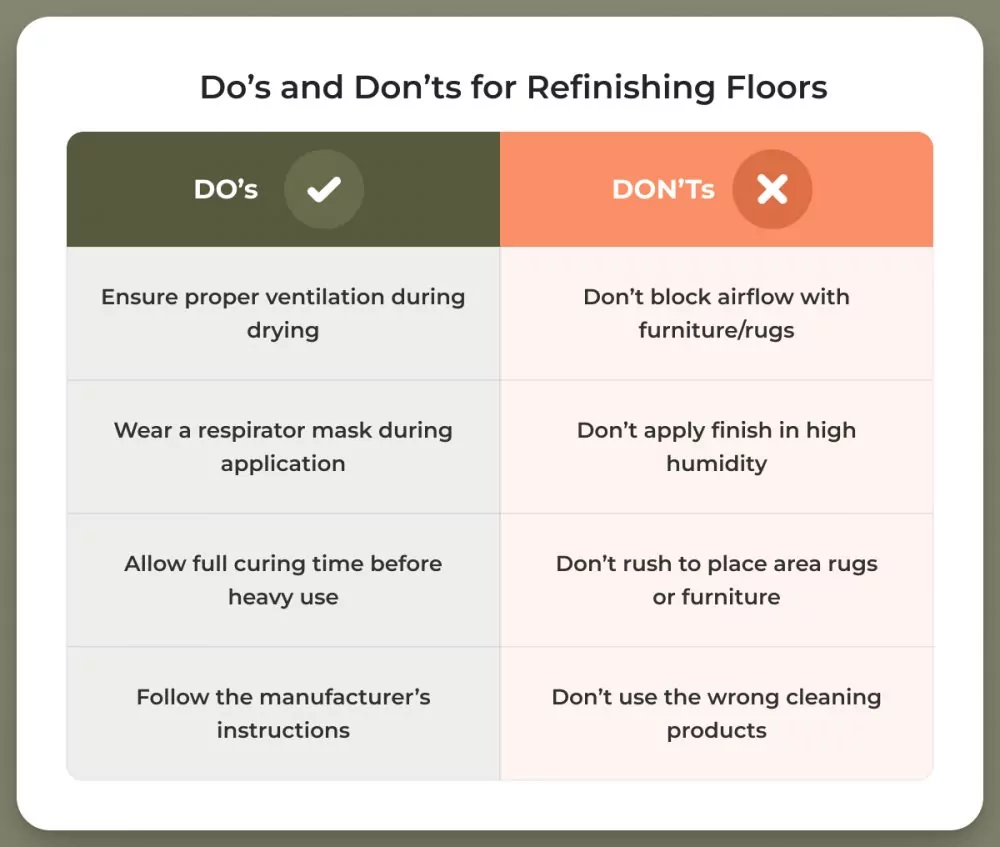
Can You Sleep Upstairs or In a Different Room While Polyurethane Floors Are Drying?
You can sometimes stay in the house and sleep in a different room while polyurethane floors are drying, but only if the refinished area is well sealed, your sleeping space is truly separate, and ventilation pulls fumes out of the house instead of toward bedrooms.
If the polyurethane smell is still strong near where you sleep, or you have kids, pregnancy, or asthma in the home, it’s safer to treat the job like a full-house event and spend a few nights elsewhere.
When people ask “can I stay in my house while floors are refinished?”, they’re usually hoping to carve out one safe pocket in a house that’s otherwise a work zone. That can work in some layouts with doors, distance, and good airflow. In open plans, or when the refinished area sits in the center of the home, polyurethane fumes tend to drift everywhere, and your safe room stops being all that safe.
Is It Safe to Stay in the House If Only One Room or One Floor Is Being Refinished?
It can be reasonably safe for healthy adults to stay in the house when only one room or one floor is being refinished, as long as that area is taped off, doors stay closed, and your sleeping space is on the opposite side of the house with its own windows for fresh air. If the refinished room sits in the middle of the floor plan and you smell the finish in every hallway, it’s better to assume the whole house shares the same air and not sleep there.
In the best cases, you have a spare bedroom or guest suite behind a solid door, with the work happening at the far end of the home and fans pulling air out through nearby windows.
In the worst cases, we’re coating a central living room, hall, or staircase that every route passes through. If you have to walk through a heavy polyurethane cloud just to reach the bathroom or kitchen, sleeping in the house after refinishing wood floors stops being a smart compromise.
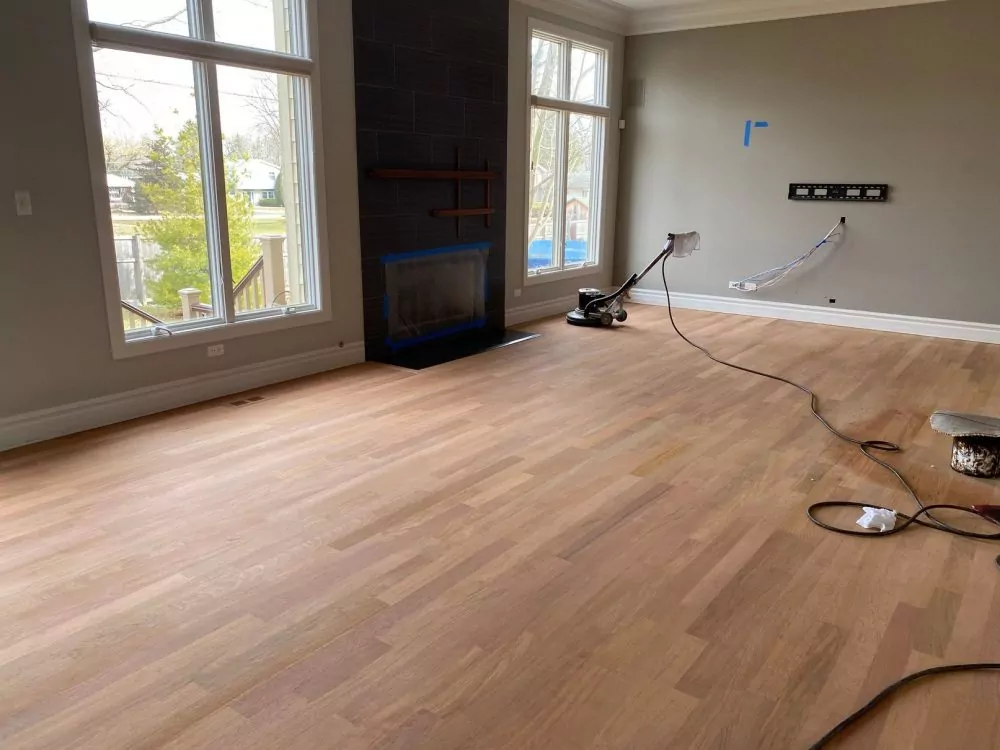
Can You Sleep in the Basement or On the Second Floor If the Main Floor Was Just Refinished?
You should only sleep in the basement or on the second floor after the main floor is refinished if the smell on that level is faint and you can ventilate it without pulling more fumes from the job site.
If the stairwell or hallway between floors still smells like fresh coating, both levels are breathing the same air and neither is a great place to spend the night.
Air doesn’t care about floor labels. It follows fans, open doors, and ductwork. In some houses, fumes drift upward and hit bedrooms. In others, they sink into a cool basement and linger. If your nose catches polyurethane on the stair run, you can assume those polyurethane fumes will be with you in bed. Truly separate levels — like a basement apartment with its own exterior door and a closed fire door to the main floor — are the exception, not the rule.
What Are Your Options If You Live in a Small Apartment or Condo with No Safe Room?
In a small apartment or condo where every corner shares the same air, you generally should not sleep there right after polyurethane floor refinishing, especially with oil-based finishes or a full-unit job. In that situation, the whole space behaves like one big refinished room, and the realistic plan is to find another bed for the first few nights.
Studio layouts and tight condos don’t let you close a door and keep the smell away. The living area, kitchen, and sleeping nook breathe the same air, and any fan mostly stirs it around unless it’s blowing straight out a window.
Even with water-based products, the first 24–72 hours are when polyurethane fumes and odor are strongest. That’s why, when I work in small units, we talk early about where to sleep and how to air out the house after floor refinishing so you return to a place that feels like home again, not a one-room chemical box.
What Are the Health Risks of Sleeping in a House with Fresh Polyurethane Fumes?
Sleeping in a house full of fresh polyurethane fumes can trigger headaches, nausea, dizziness, and breathing irritation, and those effects hit faster and harder for kids, pregnant women, and anyone with asthma or chemical sensitivity.
For most healthy adults, short exposure to a strong polyurethane smell is usually irritating rather than dangerous, but using your bedroom as a gas chamber for a few nights is not a good experiment.
Polyurethane finishes release VOCs while they dry and cure, and breathing in polyurethane in a closed room for eight hours is very different from walking through the hallway for twenty seconds.
What Common Symptoms Show That Polyurethane VOC Levels Are Too High?
If the air is loaded with polyurethane fumes, the first warning signs are usually headache, dizziness, nausea, burning eyes, or a scratchy throat while you’re in the house, and relief when you step outside. Those are your body’s way of saying the VOC level is too high for comfort, even if the floor looks perfect.
Here are the most common red flags my clients report when the polyurethane smell is too strong:
- A dull or throbbing headache that builds up after you’ve been inside for a while.
- Light-headedness, feeling spacey, or mild dizziness that eases in fresh air.
- Nausea or a sour stomach without any obvious food cause.
- Burning, watering eyes or a raw feeling in the nose and throat.
- Coughing, wheezing, chest tightness, or shortness of breath, especially in people with asthma or other lung issues.
If you notice symptoms that stop once you move away from the refinished space, that’s your clue that the VOCs are driving them.
If those symptoms do not ease after you get into fresh air, or if breathing feels difficult, call a medical professional.
Why Does the New Floor Smell Linger and Is It Actually Toxic?
The new floor smell lingers because polyurethane keeps releasing small amounts of VOCs for days or even weeks as it cures, long after it feels dry under your feet. That smell is a rough marker that chemicals are still evaporating, but it’s not a precise measure of how toxic the air is at any given moment.
When people ask “how long are polyurethane fumes toxic?” or “how long does polyurethane smell last?”, they’re usually mixing two separate ideas. The strongest, most irritating phase is in the first few days, when off-gassing is highest and the house may feel unlivable for sleep.
After that, levels drop a lot, but trace amounts can hang around as a faint odor, especially in tight houses with poor ventilation. The nose can still pick up that faint scent even when the health risk for most healthy adults is low.
That’s why no smell doesn’t automatically mean zero chemicals, and a light smell doesn’t automatically mean danger.

What Should You Do If You Already Slept In The House Too Soon After Polyurethane Refinishing?
If you already slept in the house too soon after hardwood floor refinishing and now feel off, the first step is to get everyone into fresh air and see how quickly those symptoms ease; the next step, if breathing is difficult or symptoms are strong, is to call a doctor or poison control instead of trying to ride it out. You can always come back to admire the floor later — there is no prize for toughing out sleeping in a house after refinishing wood floors when your body is clearly protesting.
- Step outside and reset. Take yourself (and especially kids, pregnant family members, and anyone with asthma) out of the house for a while. If the headache, dizziness, or nausea start to fade within minutes outside, that points straight at breathing in polyurethane as the trigger.
- Check symptom severity. Mild headache or slight eye irritation that fades outside is annoying but usually not an emergency. Trouble breathing, chest tightness, wheezing, confusion, or vomiting are a different story and deserve immediate medical attention.
- Call a professional when in doubt. A doctor or poison control center can walk you through the next steps based on your age, health, and symptoms. Don’t crowdsource that decision from random comments online.
- Re-think your timeline. Once everyone is safe, treat the house like an active work zone again. Open windows, set up fans to exhaust air outside, and give the floors more time before you even think about another night there. In practice, that often means honoring the same 2–3 day window for water-based finishes and a 3–7 day window for oil-based finishes before you try sleeping inside again.
When Is It Safe for Kids, Pregnant Women, And Pets to Return After Refinishing Floors?
Children, pregnant women, people with asthma, and pets should always come back later than healthy adults, especially if the polyurethane smell is still noticeable anywhere near where they sleep. The more vulnerable the lungs or the developing body, the more you want to overshoot the timeline instead of cutting it close.
When Can Babies and Toddlers Safely Return to the House and Sleep After Floor Refinishing?
Babies and toddlers should return to sleep in a house with refinished floors several days later than healthy adults, after the strongest polyurethane fumes are gone, the smell is faint or barely there, and the home has had continuous ventilation. If adults still notice a strong odor, small kids simply shouldn’t be sleeping there yet.
Little kids are closer to the floor and breathe faster, so whatever is in the air and hovering near the surface hits them harder. If I’d be comfortable with healthy adults sleeping in the house after, say, 2–3 nights out with water-based polyurethane, I’d want babies and toddlers to be on a longer timeline, especially for overnight stays in rooms near the refinished area.
- Let adults test the space first for short periods while windows are open.
- If nobody gets headaches, coughing, or irritated eyes, and the polyurethane smell is down to a mild new floor scent, you can start planning kids’ return.
If you’re unsure, ask your pediatrician.
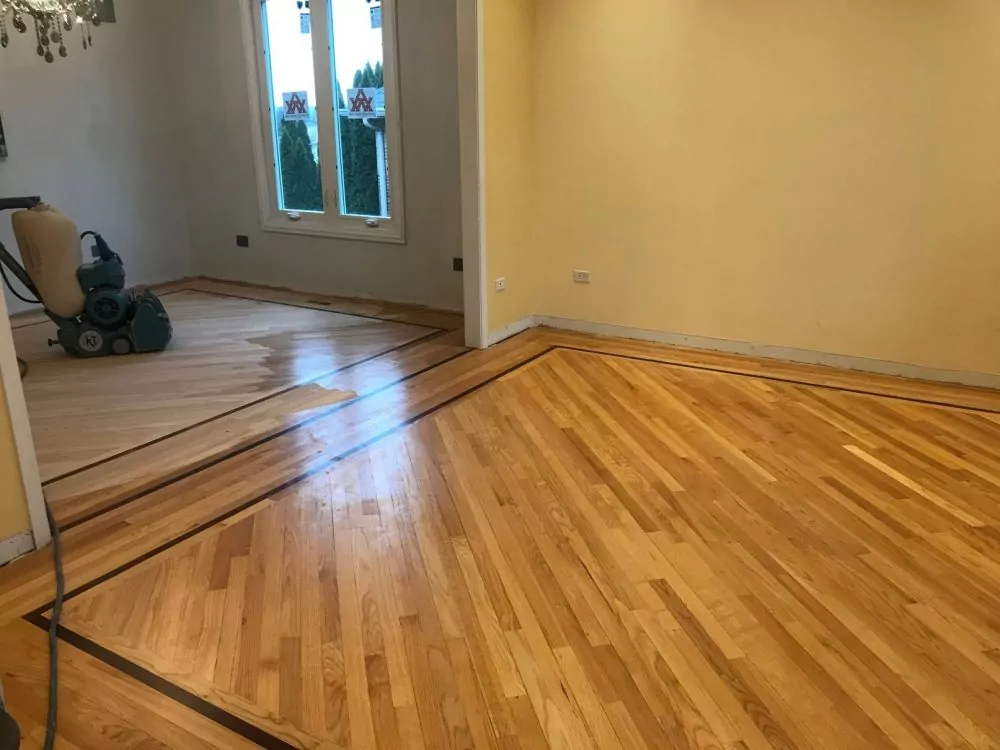
Is Polyurethane Smell Harmful During Pregnancy?
During pregnancy, it’s best to avoid sleeping in a house with a strong polyurethane smell and to stay out longer than you would if you weren’t pregnant, especially in the first days after wood floor refinishing. If the odor is still strong enough to bother you when you walk in, that’s not a space where a pregnant person should spend the night.
- Let the refinishing finish completely, then start the clock.
- Give the house aggressive ventilation for several days — windows open, fans exhausting air out, HVAC bringing in as much fresh air as possible.
- Have someone else test the space first for short visits and watch for headaches, nausea, or breathing issues.
For my own clients, I always recommend pregnant women be among the last to sleep in the house again, and to discuss timing with their OB or midwife. Your baby comes first.
How Long Should People with Asthma, Allergies, Or Chemical Sensitivity Wait Before Sleeping in the House?
People with asthma, strong allergies, or chemical sensitivity should only start sleeping in the house again once the polyurethane smell is very faint or gone and they’ve already tolerated short visits without any symptoms. In practice, that usually means waiting longer than the general 2–3 days for water-based finishes and 3–7 days for oil-based, not less.
If breathing in polyurethane makes a healthy person slightly uncomfortable, it can tip someone with asthma straight into a flare.
- Let healthy adults go back first and stay for short periods while the home is still airing out.
- If nobody reacts and the odor is down to a light background scent, then the person with asthma or allergies can try a brief visit, with an inhaler or medication handy if their doctor recommends one.
- Only when they can be in the space without tightness, coughing, or headaches does it make sense to consider sleeping in the house after refinishing hardwood floors.
If symptoms start or breathing feels even slightly off, that’s a sign to back out and call a doctor, not a sign to push through it.
How Can You Protect Pets from Polyurethane Fumes and Decide When They Can Come Back?
Pets should also stay out of the house until the polyurethane fumes have dropped and the smell is mild, with birds and small animals given the longest buffer. A good rule of thumb is to bring animals back after you’d be comfortable letting kids and sensitive adults sleep there, not before.
- Dogs and cats can often come home once the air is well ventilated, the odor is light, and you’re not seeing any eye or nose irritation in people. They should still be kept off the refinished area until the floor is fully ready for paw traffic.
- Birds are much more fragile when it comes to fumes. They should be completely out of the refinished space (ideally in another home) until there is virtually no odor left.
- Fish and small caged animals can be affected if the room they’re in is full of polyurethane smell, especially in tight spaces. If they stay in the home at all, they need to be as far from the work as possible, with lids secure and extra fresh air.
How Can You Remove Polyurethane Smell and Speed Up the Time When It’s Safe to Sleep in the House?
You can shorten the time your house smells like fresh polyurethane by moving a lot of clean air through the space, exhausting fumes outside, and supporting the drying conditions the finish needs.
First, let the finish reach the point where air movement won’t blow dust into it. Second, treat the house like you’re flushing out smoke after a kitchen fire. Strong, consistent ventilation is what makes polyurethane smell to go away in days instead of weeks.
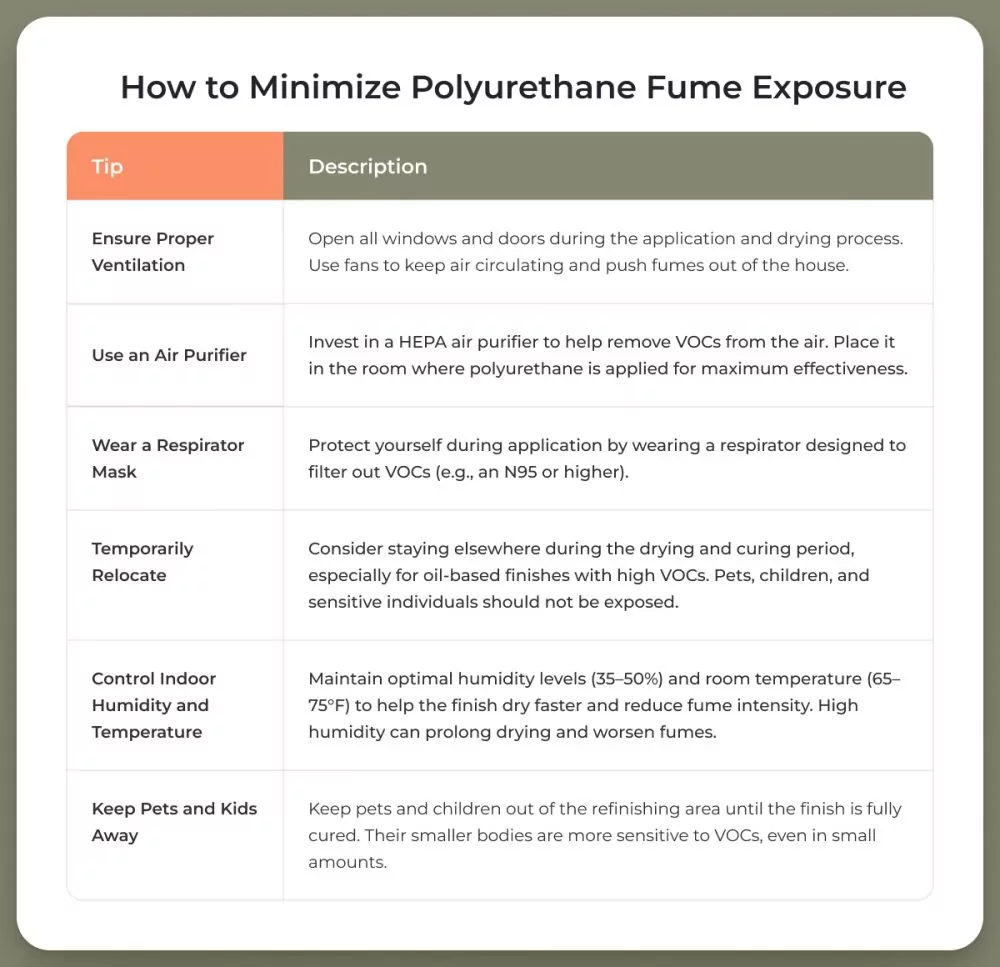
Does Opening Windows and Creating Cross-Ventilation Help Polyurethane Cure Faster?
Yes, opening windows and creating cross-ventilation is one of the best ways to reduce polyurethane fumes and move you closer to a sleep-safe house, as long as you start once the finish is past the “dust will stick to it” phase. Fresh air doesn’t magically erase VOCs, but it stops them from building up and helps them leave the building instead of circling the hallway.
- Waiting until your finisher says it’s okay to start stronger airflow, so you don’t blow debris into a tacky coat.
- Opening windows on opposite sides of the house to create a path for air to travel.
- Using box fans in windows pointed out, so they pull contaminated air outside and draw clean air in from other openings.
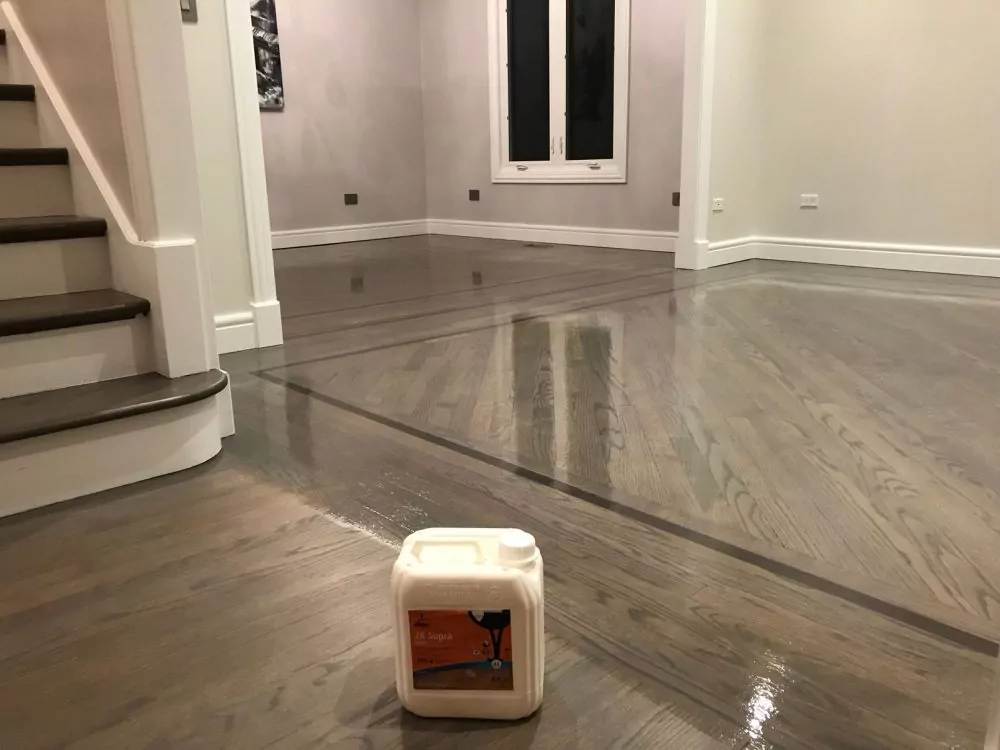
Can Air Purifiers and Dehumidifiers Help Reduce Polyurethane VOCs And Odor?
Air purifiers and dehumidifiers can help with polyurethane smell, but they’re supporting actors, not a substitute for open windows and exhaust fans. A purifier with a real activated carbon filter can grab some VOCs from the air, while HEPA alone mainly handles dust and particles, not the fumes you’re worrying about.
Dehumidifiers play a different role. When the air is too damp, polyurethane dries and cures more slowly. Keeping humidity in the ideal range recommended by the manufacturer lets the finish harden on schedule.
What Can You Do in Winter or Bad Weather If You Cannot Keep Windows Fully Open but Still Need a Safe Place to Sleep?
In winter or bad weather, you can still clear polyurethane fumes by airing out the house in shorter, stronger bursts and using your exhaust fans and HVAC system to move air without freezing everyone. You trade fewer hours of wide-open windows for several rounds of quick, aggressive ventilation.
- Open windows wide for 5–10 minutes in key rooms a few times a day, with interior doors open so stale air can rush out and fresh air can rush in.
- Run bathroom and kitchen exhaust fans to help pull contaminated air outside.
- Use the HVAC fan setting (fan on rather than auto) to keep air mixing, and, if your system allows, bring in some outside air rather than only recirculating.
| Weather / House Type | Small Apartment / Studio | Closed-Plan House | Open-Plan Main Floor |
| Mild / Warm Weather | Box fan in window blowing out | Windows open on opposite sides | Max windows open across main floor |
| Second window slightly open | Fan exhausting near refinished area | Two or more box fans exhausting out | |
| Limit time inside first 24–48 hours | Interior doors open for cross-breeze | HVAC fan on “circulate” | |
| Cold Winter | Short “shock” airing 5–10 minutes a few times a day | Door to refinished area mostly closed between airing cycles | Short, strong airing cycles |
| Bathroom and kitchen exhaust fans on | Timed window openings on that floor | Powerful exhaust fans, then close most windows | |
| HVAC fan on to mix air | Exhaust fans pulling from work zone | Avoid sleeping on that level early on | |
| Rainy / Humid Weather | Window partly open with fan exhausting out | Dehumidifier near refinished rooms | Ventilate when rain eases |
| Dehumidifier in main area | Cross-ventilation during breaks in rain | Strong dehumidifier to support curing | |
| Avoid extra steam (shorter hot showers) | Use windows under roof/overhang more | Add extra days before sleeping there |
Final Thoughts
Sleeping in a house after refinishing floors is less about how shiny the polyurethane looks and more about what you’re breathing all night. Water-based finishes with lower VOCs usually let healthy adults come back sooner. Oil-based polyurethane, big floor areas, and vulnerable family members all stretch the timeline and make patience the smarter move.
At Big Bro Hardwood, we design our jobs around your safety. We primarily use modern, high-quality water-based and low-VOC systems whenever they’re a good fit, so your floors look great, and you are safe.
If you’re in the Chicago area and thinking about hardwood floor refinishing, or you’re already halfway into planning and worried about the air side of things, give Big Bro Hardwood a call. We’ll help you choose the right system, set realistic expectations for when you can move back in, and get you to that sweet spot where your floors look new and your home air feels calm again.

Refinishing
frequently asked questions
Can polyurethane fumes kill you?
In a normal home with some ventilation, polyurethane fumes are very unlikely to be deadly, but they can cause strong headaches, nausea, and breathing irritation. If anyone has trouble breathing or feels very unwell, get to fresh air and call a doctor or poison control.
Is Polyurethane Toxic When Dry?
Once fully cured on the floors, polyurethane is no longer considered toxic. The fumes and VOCs released during drying come from off-gassing, but they evaporate over time. After the curing process is complete, the floors are safe to use, move furniture, and won’t pose health risks.
Is it safe to run the furnace or AC after polyurethane floor refinishing?
Yes, you can run the furnace or AC, but use it to help move air, not trap it. Set the fan to circulate and combine it with open windows or exhaust fans so you’re not just recirculating polyurethane smell through the house.
Do polyurethane fumes stay in furniture, curtains, or clothes?
Soft items can hold onto polyurethane smell for a while if they were in the house during strong off-gassing. Usually, time, fresh air, and normal washing or airing-out are enough to clear it.
Overall rating
5





(2 vote(s))

 4.9
4.9





 Donatas
Donatas
Comments